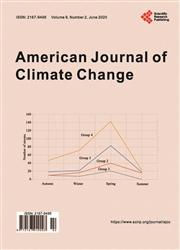Spatial and Temporal Distribution of Rainfall Breaks in Senegal
引用次数: 3
Abstract
This study analyzes the spatio-temporal distribution of daily rainfall data from 13 stations in the country of Senegal located in the North-West of Africa. These data, covering the period 1950-2010, are extracted from the database of the Regional Study Center for the Improvement of Drought Adaptation (CERAAS). They allow to calculate, in each station, dry episodes and their sequences and the results reveal a latitudinal variability of class 1 breaks (1 - 3 days) with the highest values recorded in the south. Unlike the class 2 episodes (greater or equal than 15 days), the latitudinal gradient is less pronounced but they are more frequent in the north. For most of the regions studied, a break in the trend towards an increase in dry sequences can be noted, most often at the beginning of the 1970s, which coincides with the start of the great drought of the 1970s decade. For all sites, the frequency of dry episodes of class 1 (1 - 3 days) exceeds 70%. The frequency of class 2 of dry episodes (greater or equal than 15 days) decreased from 30% in 1951-1970 to 18% in 1991-2010 in the region of Thiès; from 25% in 1951-1970 to 20% in 1991-2010 in Louga; from 22% in 1951-1970 to 18% in 1991-2010 in Tamba; 23% in 1951-1970 to 15% in 1991-2010 in Ziguinchor; 25%塞内加尔降雨断裂的时空分布
本研究分析了位于非洲西北部的塞内加尔13个站点日降水资料的时空分布特征。这些数据摘自中国干旱适应改进区域研究中心(CERAAS)数据库,涵盖1950-2010年。他们允许在每个站点计算干旱事件及其序列,结果显示1类中断(1 - 3天)的纬度变化,南方记录的最大值最高。与第2类(大于或等于15天)不同,纬度梯度不太明显,但在北方更为频繁。对于所研究的大多数区域,可以注意到干旱序列增加趋势的中断,最经常是在1970年代初,这与1970年代十年大干旱的开始相吻合。在所有站点中,1级(1 - 3天)干燥发作的频率超过70%。thi地区2类干旱事件(大于或等于15天)的发生频率从1951-1970年的30%下降到1991-2010年的18%;从1951-1970年的25%上升到1991-2010年的20%;坦巴从1951-1970年的22%上升到1991-2010年的18%;1951-1970年为23%,1991-2010年为15%;25%
本文章由计算机程序翻译,如有差异,请以英文原文为准。
求助全文
约1分钟内获得全文
求助全文

 求助内容:
求助内容: 应助结果提醒方式:
应助结果提醒方式:


